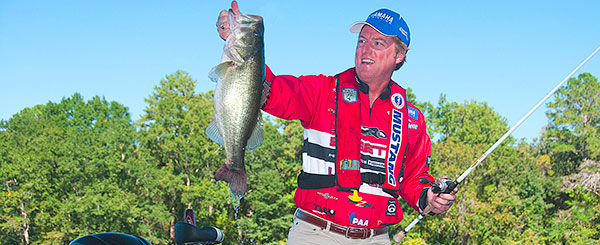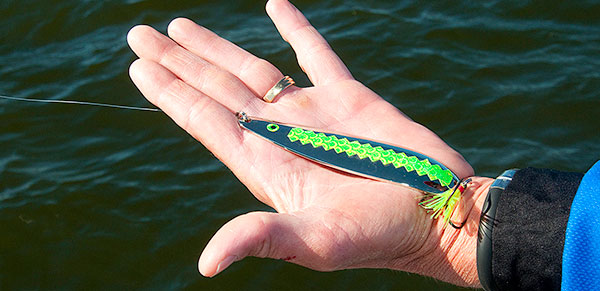Kelly Jordon likes winter spooning
If you caught 15 bass, weighing between 4 and 6 pounds, on the first 15 casts you ever made with a new lure, wouldn’t that lure become one of your all-time favorites? Of course it would, which is exactly what happened to Yamaha pro Kelly Jordon several years ago when he decided to tie on a big flutter spoon one afternoon at Lake Fork. Ever since that day, Jordon has kept a box full of spoons in his boat and ready to use, regardless of the time of year.
“I had known about the big 6-inch flutter spoons for some tim, because they’re made right at Lake Fork by a friend who had designed some special spinnerbaits for me, but I just never had considered using them. Then, when I found a school of bass suspended about 25 feet deep off an old sunken bridge and didn’t have any other lures I could use efficiently at that depth, I put one on.
“On my first cast, I counted it down to what I thought would be the right depth, jerked it once, and a 6-pound bass just slammed it. I caught a 4-pounder the next cast, and that’s how it started. I caught 15 bass on my first 15 casts before I lost one.”
Jordon has caught fish on them from 10 feet down to about 50 feet, but knows other anglers who’ve caught bass as deep as 80 feet with the big spoons.
“The winter months are a good time to use big spoons because they do work so well in deep water,” says Jordon, “especially when the fish are very close to the bottom. I like to make a cast, let the spoon sink completely to the bottom, then hop it lightly. I do this with my rod tip and only hop the lure 6-12 inches up above the bottom at a time, and after two or three hops, I’ll just let the spoon lie motionless.
“I have actually had bass pick up my spoon when it is lying on the bottom, but not often. Most strikes come either as the spoon begins its upward movement, or when it’s falling.”
If he locates bass suspended 5-6 feet above the bottom, Jordon will still begin by making short bottom hops with the spoon, but then he’ll suddenly rip the lure up through the fish and let it fall again. When fish are suspended even higher, he’ll cast beyond them, let the spoon sink, then begin swimming it back, sometimes reeling really fast, then stopping so the spoon sinks. Because of the way they are designed, these lures flutter as they’re falling, too.
“These are definitely larger-than-normal lures, and I believe bass can see them better from a distance, so the strike zone is actually increased. Bass may also be more interested because they are not accustomed to seeing large lures in the winter months. This is the time of year we normally downsize to finesse techniques.
“These big spoons are not effective around vegetation because the dangling treble hook does get snagged, but they’re excellent winter choices around deeper structure like ledges and breaklines, humps and high spots, and certainly along sunken roadbeds and old bridges. If they do snag, you can usually jiggle them free because they’re so heavy.
“Fishermen have been using these types of spoons for years to catch big northern pike and muskie, but they really never gained that much popularity for bass, even though they’re easy lures to fish.”I was a perfect example of a fisherman who was reluctant to tie one on, but it only took 15 casts to make me change my mind.”
Category: Fishing Tips/Techniques, TX







